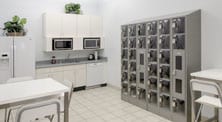Policies and operations may be the foundation of a loss prevention strategy, but it takes significant cultural change, input from all levels of employees, and a collective effort on behalf of all departments to ultimately have a positive effect on reducing shrinkage. No single employee or department can combat this on their own.
The first step toward fostering a culture of loss prevention in the retail environment is to develop a strategic, multifaceted approach whose foundation is a system of values shared by facility management, operations, visual merchandising, and loss prevention. By establishing and encouraging a shared culture, each department can work toward its individual goals while sustaining the larger goal of reducing shrinkage.
For example, by increasing employee presence near high-value items that are easily concealable but also most profitable when displayed near store entrances, employees can better monitor for theft while providing enhanced customer service. Setting the scene for employees and customers when they enter the store will let both parties know that the establishment takes theft seriously.

Get in the “Zone”
“Zones of influence” is a well-known concept in loss prevention that refers to the various areas that are implicated in loss prevention strategies. Extending from the asset itself and its immediate surroundings to the exterior of the store, public spaces, and even the home environment, these zones reflect the varying degrees to which measures can be implemented to achieve a comprehensive and effective loss prevention model. Increased situational awareness, closely monitored employee activity, and specifically tailored responses to events in each zone can help to foster a holistic culture of loss prevention.
Tools of the Trade
Generally speaking, solutions address loss prevention efforts by doing one or more of the following:
- Increasing effort or the physical difficulty associated with stealing (such as bolted down or encased product).
- Increasing risk or the odds of being caught (such as alarms or products that make a noise to alert an associate or that capture an image).
- Decreasing reward (such as when the removal process damages or marks the item or an item is prevented from being activated until purchased).
Installing or upgrading to electronic locks on casegoods displaying CRAVED (concealable, removable, available, valued, enjoyable, and disposable) merchandise increases both the effort associated with theft and the risk of being caught. In addition to mitigating the efforts of potential thieves, electronic locks offer flexible and easy management. Some electronic locks, such as Numeris by Digilock, also have added features, such as the capacity to conduct audit trails. In the case of internal theft, this feature allows loss prevention to identify the last employee or manager who accessed the merchandise.
A Proactive Approach
While reactive solutions such as these can be effective, a comprehensive loss prevention program should also incorporate proactive measures. One example of a proactive solution is a locker bank located in an employee break room. When a new employee takes a tour of an establishment, it is important to create a memorable first impression for that new hire. This conveys that the company cares about employees and their needs and also provides employees with a sense of pride in their company. Providing employees with a secure location for their belongings reduces opportunity for potential employee-on-employee theft and ensures that employees are not distracted while on the floor.
Customizations to the lockers, such as electronic locks or clear polycarbonate doors, may also deter employees from hiding stolen merchandise in their lockers and can be useful for managers needing to conduct visual audits of their employees’ lockers. For more information on how LockUp lockers can enhance loss prevention efforts in retail establishments, visit lockup.com.
No Better Time than Now
With nearly $50 billion lost to shrinkage every year and customer expectations changing constantly, retailers must find innovative ways to reduce shrink without affecting customer experience and impacting sales growth. Attempting to eradicate theft altogether may be an insurmountable task, but fostering a holistic culture of loss prevention encourages all levels of employees and departments to take part in the prevention of shrinkage.
![]()


